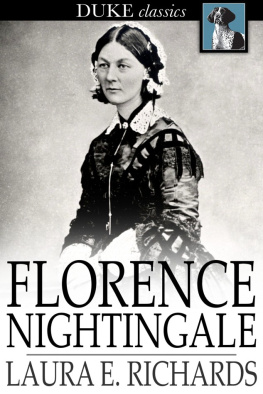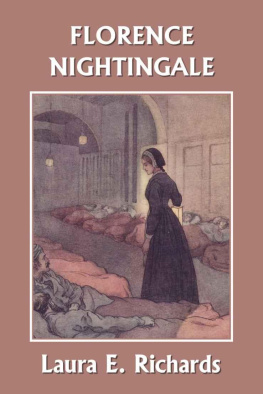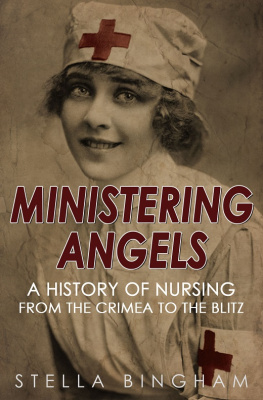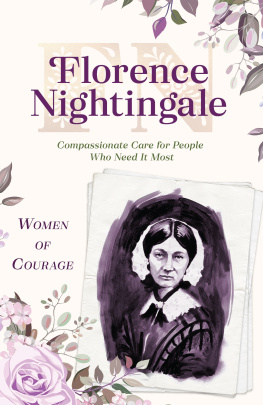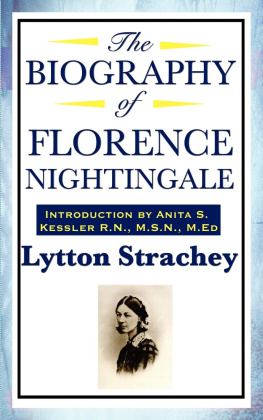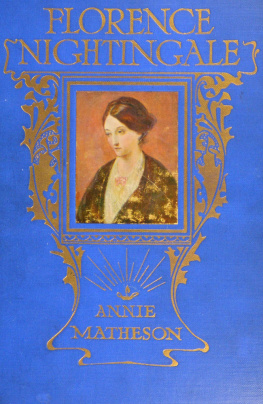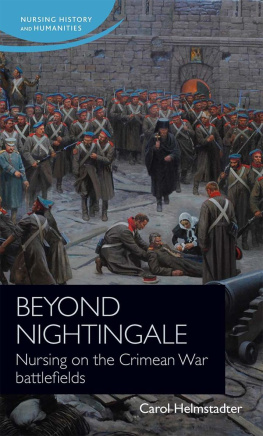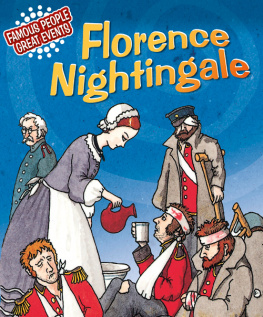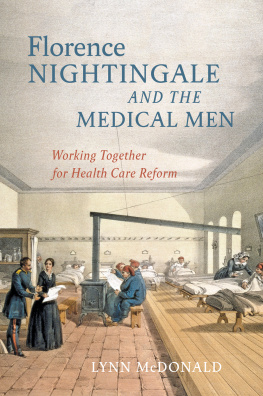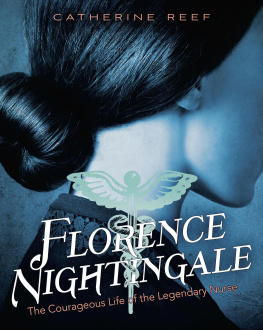FLORENCE NIGHTINGALE
THE ANGEL OF THE CRIMEA, A STORY FOR YOUNG PEOPLE
* * *
LAURA E. RICHARDS
*
Florence Nightingale
The Angel of the Crimea, a Story for Young People
First published in 1909
ISBN 978-1-62013-817-5
Duke Classics
2014 Duke Classics and its licensors. All rights reserved.
While every effort has been used to ensure the accuracy and reliability of the information contained in this edition, Duke Classics does not assume liability or responsibility for any errors or omissions in this book. Duke Classics does not accept responsibility for loss suffered as a result of reliance upon the accuracy or currency of information contained in this book.
Contents
*
*
To
THE SISTER ELEANOR
OF THE SISTERHOOD OF SAINT MARY
HERSELF THROUGH MANY LONG YEARS A DEVOTED
WORKER FOR THE POOR, THE SICK, AND THE
SORROWFUL, THIS BRIEF RECORD OF AN
HEROIC LIFE IS AFFECTIONATELY
DEDICATED
For the material used in this little book I am chiefly indebted to Sarah A. Tooley's "Life of Florence Nightingale," and to Kinglake's "Invasion of the Crimea."
Chapter I - How Florence Got Her NameHer Three Homes
*
One evening, some time after the great Crimean War of 1854-55, a companyof military and naval officers met at dinner in London. They weretalking over the war, as soldiers and sailors love to do, and somebodysaid: "Who, of all the workers in the Crimea, will be longestremembered?"
Each guest was asked to give his opinion on this point, and each onewrote a name on a slip of paper. There were many slips, but when theycame to be examined there was only one name, for every single man hadwritten "Florence Nightingale."
Every English boy and girl knows the beautiful story of MissNightingale's life. Indeed, hers is perhaps the best-loved name inEngland since good Queen Victoria died. It will be a great pleasure tome to tell this story to our own boys and girls in this country; and itshall begin, as all proper stories do, at the beginning.
Her father was named William Nightingale. He was an English gentleman,and in the year 1820 was living in Italy with his wife. Their firstchild was born in Naples, and they named her Parthenope, that being theancient name of Naples; two years later, when they were living inFlorence, another little girl came to them, and they decided to name heralso after the city of her birth.
When Florence was still a very little child her parents came back toEngland to live, bringing the two children with them. First they went toa house called Lea Hall, in Derbyshire. It was an old, old house of graystone, standing on a hill, in meadows full of buttercups and clover. Allabout were blossoming hedgerows full of wild roses, and greatelder-bushes heavy with white blossoms; and on the hillside below itlies the quaint old village of Lea with its curious little stone houses.
Lea Hall is a farmhouse now, but it still has its old flag-paved halland its noble staircase of oak with twisted balustrade, and broad solidsteps where little Florence and her sister "Parthe" used to play andcreep and tumble. There was another place near by where they loved evenbetter to play; that was the ancient house of Dethick. I ought rather tosay the ancient kitchen, for little else remained of the once statelymansion. The rest of the house was comparatively new, but the greatkitchen was (and no doubt is) much as it was in the days of QueenElizabeth.
Imagine a great room with heavy timbered roof, ponderous oaken doors,and huge open fireplace over which hung the ancient roasting jack. Inthe ceiling was a little trap-door, which looked as if it might open onthe roof; but in truth it was the entrance to a chamber hidden awayunder the roof, a good-sized room, big enough for several persons tohide in.
Florence and her sister loved to imagine the scenes that had taken placein that old kitchen; strange and thrilling, perhaps terrible scenes;they knew the story of Dethick, and now you shall hear it too.
In that old time which Tennyson calls "the spacious days of greatElizabeth," Dethick belonged to a noble family named Babington. It was afine house then. The oaken door of the old kitchen opened on longcorridors and passages, which in turn led to stately halls and noblegalleries. There were turrets and balconies overlooking beautifulgardens; and on the stone terraces gay lords and ladies used to walk andlaugh and make merry, and little children run and play and dance, andlife go on very much as it does now, with work and play, love andlaughter and tears.
One of the gay people who used to walk there was Anthony Babington. Hewas a gallant young gentleman, an ardent Catholic, and devoted to thecause of the beautiful and unfortunate Mary Queen of Scots.
Though ardent and devoted, Babington was a weak and foolish young man.He fell under the influence of a certain Ballard, an artful anddesigning person who had resolved to bring about the death of the greatEnglish Queen, and was induced by him to form the plot which is known inhistory as Babington's Conspiracy; so he was brought to ruin and death.
In the year 1586 Queen Mary was imprisoned at Wingfield Manor, a countryhouse only a few miles distant from Dethick. The conspirators gatheredother Catholic noblemen about them, and planned to release Queen Maryand set her once more on the throne.
They used to meet at Dethick where, it is said, there is a secretpassage underground leading to Wingfield Manor. Perhapswhoknows?they may have sat in the kitchen, gathering about the greatfireplace for warmth; the lights out, for fear of spies, only thefirelight gleaming here and there, lighting up the dark corners and theeager, intent faces. And when the plot was discovered, and QueenElizabeth's soldiers were searching the country round for the youngconspirators, riding hither and thither along the pleasant country lanesand thrusting their sabres in among the blossoming hedgerows, it washere at Dethick that they sought for Anthony Babington. They did notfind him, for he was in hiding elsewhere, but one of his companions wasactually discovered and arrested there.
Perhapsagain, who knows?this man may have been hiding in the secretchamber above the trap-door. One can fancy the pursuers rushing in,flinging open cupboards and presses, in search for their prey; andfinding no one, gathering baffled around the fireplace. Then one,chancing to glance up, catches sight of the trap-door in the ceiling."Ha! lads, look up! the rascal may be hiding yonder! Up with you, youtall fellow!" Then a piling up of benches, one man mounting on another'sshouldersthe door forced open, the young nobleman seized andoverpowered, and brought down to be carried off to London for trial.
Anthony Babington and his companions were executed for high treason, andQueen Mary, who was convicted of approving the plot, was put to deathsoon after.
All this Florence Nightingale and her sister knew, and they never tiredof "playing suppose" in old Dethick kitchen, and living over again infancy the romantic time long past. And on Sundays the two children wentwith their parents to old Dethick church, and sat where AnthonyBabington used to sit, for in his days it was the private chapel ofDethick. It is a tiny church; fifty people would fill it tooverflowing, but Florence and her sister might easily feel that the fourbare walls held all the wild history of Elizabeth's reign.
Anthony Babington in doublet and hose, with velvet mantle, featheredcap, and sword by his side; little Florence Nightingale in round Leghornhat and short petticoats. It is a long step between these two, yet theyare the two most famous people who ever said their prayers in oldDethick church. The lad's brief and tragic story contrasts strangelywith the long and beautiful story of Florence Nightingale, a story thathas no end.

